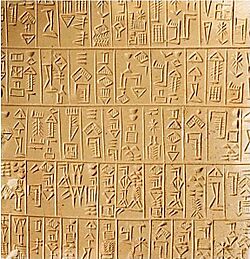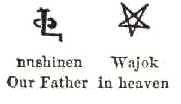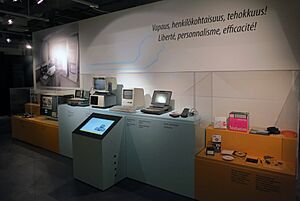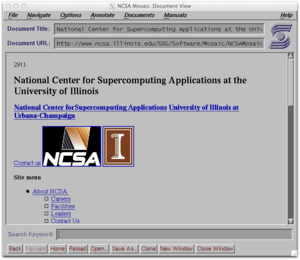History of communication facts for kids
The history of communication is all about how people have shared messages and ideas over time. It started with simple ways like talking and using symbols, and has grown into amazing technologies like the internet! Communication can be a quick chat or sharing news with millions of people.
Humans first started communicating with spoken language around 100,000 years Before Common Era (BCE). Later, about 30,000 years BCE, people began using symbols. These early symbols included cave paintings, petroglyphs (carvings on rocks), pictograms (pictures representing things), and ideograms (pictures representing ideas). Important steps forward were the invention of writing, then printing, and more recently, telecommunications and the Internet.
Contents
Early Ways to Communicate
Human communication began with spoken language about 100,000 years ago. Symbols appeared around 30,000 years ago. Even though speech wasn't perfect, it helped ideas spread. This led to new ways of communicating that allowed people to share messages over longer distances and keep information for a longer time. All these early inventions were based on using symbols.
The oldest known symbols used for communication are cave paintings. These are a type of rock art from the Upper Paleolithic age, which was a very early part of the Stone Age. The oldest known cave painting is in Chauvet Cave, made around 30,000 BCE. These paintings might have even been used to create the first calendar about 15,000 years ago. It's interesting that in Ancient Egypt and Ancient Greece, the words for "drawing" and "writing" were the same!
Petroglyphs: Carvings on Rock

The next big step in communication history was making petroglyphs. These are carvings made into rock surfaces. It took about 20,000 years for early humans to go from cave paintings to the first petroglyphs. These carvings appeared around 10,000 to 12,000 years ago, during the Neolithic and late Upper Paleolithic periods. For example, the petroglyphs on the Hawaiian islands tell stories and myths.
It's possible that early humans also used other ways to communicate, often to help them remember things. They might have used specially arranged stones, symbols carved in wood or earth, or even tattoos. However, most of these things haven't lasted until today. We can only guess about them by looking at modern "hunter-gatherer" cultures in places like Africa or Oceania.
Pictograms: Pictures That Tell a Story
A pictogram is a symbol that shows a concept, object, activity, place, or event using a picture. Pictography is an early form of proto-writing where ideas are shared through drawings. Pictograms were the next step in how communication developed. The main difference between petroglyphs and pictograms is that petroglyphs just show an event. Pictograms, however, tell a story about the event, and can even be put in chronological (time) order.
Many ancient cultures around the world used pictograms. They started appearing around 9000 BCE, when simple pictures were used to label farm produce. They became very popular around 6000–5000 BCE. These pictograms were the foundation for writing systems like cuneiform and Egyptian hieroglyphs. They began to turn into logographic writing systems around 5000 BCE.
Ideograms: Pictures for Ideas
Pictograms then developed into ideograms. These are graphical symbols that represent an idea. Pictograms could only show things that looked like their form. For example, a picture of a circle could mean the sun. But it couldn't show ideas like 'heat', 'light', or 'day'. Ideograms, on the other hand, could show more abstract concepts.
Since some ideas are understood by everyone, many different cultures created similar ideograms. For instance, an eye with a tear means 'sadness' in Native American ideograms in California. It means the same for the Aztecs, early Chinese, and the Egyptians. Ideograms were an important step before logographic writing systems fully developed.
Writing: A Big Step Forward

The oldest types of writing were mostly logographic. This means they used symbols that represented whole words or ideas, based on pictographic and ideographic elements. Most writing systems can be divided into three main types: logographic, syllabic (symbols for syllables), and alphabetic (symbols for single sounds). However, many systems use a mix of these.
The first writing systems appeared around the same time as the Bronze Age, in the late 5th millennium BCE. The first writing system is thought to have been invented in ancient Sumer. It developed into cuneiform by the late 4th millennium BCE. Egyptian hieroglyphs also appeared around this time.
The original Sumerian writing system came from using clay tokens to represent goods. By the end of the 4th millennium BCE, this turned into a way to keep track of accounts. They used a round stylus to press marks into soft clay for numbers. Later, they added pictographic writing using a sharp stylus to show what was being counted. Around 2700–2000 BCE, they started using a wedge-shaped stylus, which is why it's called cuneiform. At first, it was just for logograms, but by 2800 BCE, it included sounds. Around 2600 BCE, cuneiform began to represent syllables of the spoken Sumerian language.
Eventually, cuneiform became a general writing system for words, syllables, and numbers. By the 26th century BCE, this script was used for other languages like Akkadian, Hurrian, and Hittite.
The Chinese script might have developed on its own, separate from Middle Eastern scripts. It appeared around the 16th century BCE (early Shang dynasty). The idea for Chinese script originally came from observing bird and animal tracks. Writing systems in the Americas, like Olmec and Mayan, are also believed to have started independently.
The Alphabet

The first true alphabets appeared around 2000 BCE in Ancient Egypt. These were "abjads," where each symbol stood for a single consonant sound. However, alphabetic ideas were already part of Egyptian hieroglyphs for a thousand years before that. For example, the letter F is like the first letter of the Hebrew word "vav," which means nail.
By 2700 BCE, Egyptian writing had about 22 hieroglyphs that represented syllables starting with a single consonant sound. These symbols helped with pronunciation, grammar, and writing foreign words.
However, these Egyptian symbols weren't a complete alphabet on their own. In the Middle Bronze Age, around 1700 BCE, a new "alphabetic" system might have been developed in central Egypt by Semitic workers. We can't read these early writings, so their exact nature is still a mystery.
Over the next 500 years, this Semitic "alphabet" (which was more like a syllabary such as Phoenician writing) spread north. Almost all alphabets around the world today, except for Korean Hangul, have come from it or one of its descendants.
Experts agree that the West-Semitic alphabet led to the creation of the Greek alphabet. There's some debate about the earliest uses of the Greek alphabet because of the changes made to it.
The Greek alphabet had these features:
- The Greek letters we know today date back to the eighth century BCE.
- Early Greek writing used the 22 West-Semitic letters and added five more.
- Early Greek writing wasn't always the same everywhere; it had many local differences.
- Greek was written in a formal, carved style.
- Greek was written in a boustrophedon style, meaning lines went back and forth (right-to-left, then left-to-right).
Scholars believe that early Greek writing was very similar to the West-Semitic alphabet. Over time, changes were made to the Greek alphabet to better express the spoken Greek language.
Storytelling: The Power of Spoken Words
Verbal communication, or talking, is one of the oldest ways humans have communicated. The tradition of telling stories out loud goes back a very long time. The way people communicated verbally changed with different historical periods. The complexity of spoken communication always reflected the times. Verbal communication was not limited to one place; it was, and still is, a worldwide tradition. People communicated through songs, poems, and chants. They would gather in groups and share stories, myths, and history.
Oral poets from Indo-European regions were called "weavers of words" because they were so good at speaking and telling stories. Nomadic people, who moved from place to place, also had oral traditions. They used these to tell the history of their people and pass it on to the next generation.
Nomadic tribes were very important for keeping oral storytelling alive. For example, the nomads of Arabia used oral storytelling to share their histories and the stories of their people. Because nomadic life meant they didn't have permanent homes or many possessions, they often left few physical traces. The rich nomadic life and culture were saved by early Muslim scholars who collected the poems and stories passed down through generations. Poems created by these Arabic nomads were shared by specialists called sha'ir. These individuals spread the stories and histories of these tribes. In times of war, they would even boost morale among tribe members through their stories.
In its natural form, oral communication was, and continues to be, one of the best ways for humans to share their messages, history, and traditions with the world.
Timeline of Writing Tools
- 30,000 BC – In Europe, people marked ivory, bone, and stone with patterns to keep track of time using a lunar calendar.
- 14,000 BCE – The first known map artifact was made on bone in what is now Ukraine.
- Before 3500 BC – Communication happened through paintings by native tribes.
- 3500s BCE – The Sumerians created cuneiform writing, and the Egyptians developed hieroglyphic writing.
- 16th century BCE – The Phoenicians developed an alphabet.
- 105 CE – Cai Lun invented paper.
- 7th century – Hindu-Malayan empires wrote legal documents on copper plate scrolls.
- 751 – Paper was brought to the Muslim world after the Battle of Talas.
- 1250 – The quill pen was used for writing.
- 1795 – Nicolas-Jacques Conté invented the pencil.
- 1888 – John J. Loud invented the ballpoint pen.
- 1938 – László Bíró invented the first successful ballpoint pen for sale.
Timeline of Printing Technology
- 1305 – The Chinese developed wooden block movable type printing.
- 1440 – Johannes Gutenberg invented a printing press with metal movable type.
- 1844 – Charles Fenerty made paper from wood pulp, which was cheaper than rag paper.
- 1849 – Associated Press used a pony express to carry European news to New York newspapers.
- 1938 – Chester Carlson invented the first photocopier for office use.
- 1959 – Xerox started selling the Xerox 914 photocopier.
History of Telecommunication
The history of telecommunication is about sending signals over a distance to communicate. This started thousands of years ago with smoke signals and drums in Africa, America, and parts of Asia. In the 1790s, the first fixed semaphore systems appeared in Europe. But it wasn't until the 1830s that electrical telecommunication systems began to show up.
Before Electricity
- 26–37 CE – Roman Emperor Tiberius ruled from the island of Capri by sending messages with metal mirrors that reflected the sun.
- 1520 – Ships on Ferdinand Magellan's voyage signaled to each other by firing cannons and raising flags.
- 1792 – Claude Chappe invented the semaphore telegraph.
Telegraph
- 1792 – Claude Chappe set up the first long-distance semaphore telegraph line.
- 1831 – Joseph Henry suggested and built an electric telegraph.
- 1836 – Samuel Morse developed Morse code.
- 1843 – Samuel Morse built the first long-distance electric telegraph line.
Landline Telephone
- 1876 – Alexander Graham Bell and Thomas A. Watson showed off an electric telephone in Boston.
- 1889 – Almon Brown Strowger patented the direct dial telephone system.
Phonograph (Record Player)
- 1877 – Thomas Edison patented the phonograph.
- 1977 – William K. Heine invented the laser turntable.
- 1997 – ELP offered the first commercial laser turntable for sale.
Radio and Television
- 1920 – Radio station KDKA in Pittsburgh began the first radio broadcast.
- 1925 – John Logie Baird sent the first television signal.
- 1942 – Hedy Lamarr and George Antheil invented a communication technique called frequency-hopping spread spectrum.
- 1947 – Full-scale commercial television broadcasts began.
- 1963 – The first geosynchronous communications satellite was launched.
- 1999 – Sirius Satellite Radio was introduced.
Fax Machine
- 1843 – A patent was given for the "Electric Printing Telegraph," an early version of the fax machine.
- 1926 – The radioax became available for commercial use.
- 1964 – The first modern fax machine was sold (Long Distance Xerography).
- 1996 – The first internet fax machine was created.
Mobile Telephone
- 1947 – Douglas H. Ring and W. Rae Young of Bell Labs suggested a cell-based approach, which led to "cellular phones."
- 1957 – Leonid Kupriyanovich invented the LK-1 mobile radio telephone.
- 1981 – Comvik introduced the world's first automatic mobile phone service.
- 1991 – GSM mobile networks started operating.
- 1992 – Neil Papworth sent the first SMS (text message).
- 2001 – The first commercial 3G network was launched in Japan by NTT DoCoMo.
- 2007 – The first iPhone was launched.
- 2009 – The first commercial LTE (4G) network was deployed.
- 2014 – The number of mobile connections became more than the global population.
- 2019 – The first 5G networks were launched in South Korea.
Computers and the Internet
- 1946 – The University of Pennsylvania introduced ENIAC, the first programmable, electronic, general-purpose digital computer.
- 1949 – Claude Shannon, known as the "father of information theory," proved an important mathematical theorem about signals.
- 1957 – Gordon Gould invented the laser and the optical amplifier.
- 1965 – The first email was sent (at MIT).
- 1966 – Charles K. Kao realized that fiber optics could transmit light.
- 1969 – The first computers of ARPANET, the Internet's ancestor, were connected.
- 1971 – Erna Schneider Hoover invented a computerized system for telephone traffic.
- 1971 – The 8-inch floppy disk was introduced for computer storage.
- 1973 – Optelecom, Inc. delivered the first working optical communication system.
- 1975 – The first list servers (for email lists) were introduced.
- 1976 – The personal computer (PC) market began.
- 1977 – Donald Knuth started working on TeX (a typesetting system).
- 1980 – Usenet (an early online discussion system) was established.
- 1981 – The Hayes Smartmodem was introduced, allowing computers to connect over phone lines.
- 1983 – Microsoft Word software was launched.
- 1985 – AOL (America Online) was launched.
- 1988 – Internet Relay Chat (IRC) was released.
- 1989 – Tim Berners-Lee and Robert Cailliau built the prototype system that became the World Wide Web at CERN.
- 1989 – WordPerfect 5.1 word processing software was released.
- 1989 – Lotus Notes software was launched.
- 1990 – Adobe Photoshop was released.
- 1991 – Anders Olsson transmitted data at 32 billion bits per second through an optical fiber.
- 1992 – The Internet2 organization was created.
- 1992 – The IBM ThinkPad 700C laptop computer was created; it was much lighter than older laptops.
- 1993 – Mosaic graphical web browser was launched.
- 1994 – Internet radio broadcasting began.
- 1996 – The first Dense Wave Division Multiplexing (WDM) system was installed by Ciena Corp. WDM became the basis for all telecommunications networks and a foundation of the Internet.
- 1996 – The Motorola StarTAC mobile phone was introduced; it was much smaller than previous cellphones.
- 1997 – SixDegrees.com was launched, one of the first social networking services.
- 1999 – Napster peer-to-peer file sharing was launched.
- 1999 – XMPP (a communication protocol) was released.
- 2001 – Cyworld added social networking features and became a popular social networking service.
- 2003 – Skype video calling software was launched.
- 2004 – Facebook was launched, becoming the largest social networking site by 2009.
- 2005 – YouTube, the video-sharing site, was launched.
- 2005 – Reddit was launched.
- 2006 – Twitter was launched.
- 2007 – The iPhone was launched.
- 2009 – WhatsApp was launched.
- 2010 – Instagram was launched.
- 2011 – Snapchat was launched.
- 2015 – Discord was launched.
See also
- Animal communication
- Biocommunication (science)
- Biosemiotics
- Cylcon
- Historical linguistics
- History of ancient numeral systems
- History of art
- History of writing
- Message stick
- Plant communication
- Prehistoric counting
- Proto-writing





